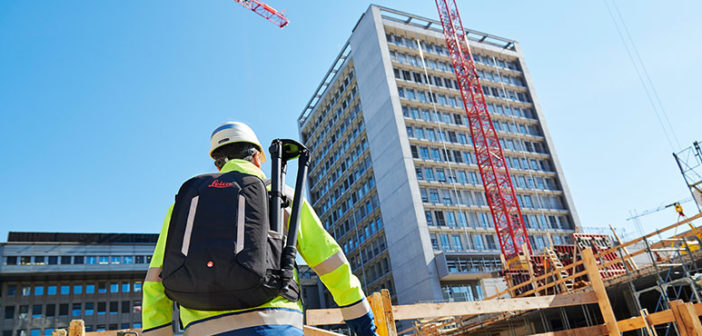Terrestrial laser scanning is the process of collecting and analysing a real-world physical space even in places that are hard to reach in order to have a digital representation which accurately defines key characteristics of objects within that space, such as size, shape, location, condition and distance from other objects. By shooting a laser beam in every direction, laser scanners rapidly capture millions or even billions of measurement points within line of sight in the surrounding environment and these measurement points are known as a ‘point cloud’. Laser scanners, if used correctly, ensure that there’s no missing data and the point cloud information can be used to create an immersive 3D digital model that can be explored from different viewing angles.
These 3D models can be applied across a broad range of use cases to serve two critical needs. The first is access to accurate data – essentially freezing a scene or space in time including high-resolution imagery. The second is the ability to analyse and manipulate the data in order to create a digital representation of a space. The models can be used to support a prosecution case in a courtroom with an accurate model of a crime scene, or to ensure the stage set of a Broadway Show is installed on time, or for repurposing and maintaining a property development.
There are three fundamental rules for ensuring the data is accurately scanned. These tips are useful whether you’re an experienced surveyor or you’re new to laser scanning:
1. Understanding project requirements in advance
 First and foremost you need to understand what information is required and the capabilities of the scanner you’re using. Laser scanning enables you to capture everything but it’s still important to understand what details are important to the project. This might be a bullet casing if you’re working on a forensic report or a specific valve if it’s a building development or number of rooms you need to scan to ensure that you capture everything you’ll need and the data isn’t distorted.
First and foremost you need to understand what information is required and the capabilities of the scanner you’re using. Laser scanning enables you to capture everything but it’s still important to understand what details are important to the project. This might be a bullet casing if you’re working on a forensic report or a specific valve if it’s a building development or number of rooms you need to scan to ensure that you capture everything you’ll need and the data isn’t distorted.
With some scanners, for example, you need to be closer to an object to get the level of detail required but with others you can be further away from an object and still capture all of the data. Understanding what information is needed and how to get the best out of the scanner you’re using will help prevent time being wasted and costly site revisits to recollect the data. It’ll also make the data registration easier.
2. Setting up your scans
 If you’re using a stationary laser scanner, think ahead to where your next setup will be and make sure you have a clear line of sight to the next location. Line of sight is a straight line or path from an observer’s eye to a distant point that provides an unobstructed view. When possible, walk the site before scanning, particularly if you have a large job where you need to collect more than 100-plus scans. Creating a sitemap in advance can help you identify locations where you’re going to scan from ahead of time to ensure the correct overlap of scan data with minimal obstructions so the final data comes together seamlessly in post-processing.
If you’re using a stationary laser scanner, think ahead to where your next setup will be and make sure you have a clear line of sight to the next location. Line of sight is a straight line or path from an observer’s eye to a distant point that provides an unobstructed view. When possible, walk the site before scanning, particularly if you have a large job where you need to collect more than 100-plus scans. Creating a sitemap in advance can help you identify locations where you’re going to scan from ahead of time to ensure the correct overlap of scan data with minimal obstructions so the final data comes together seamlessly in post-processing.
To ensure the correct overlap of data with no missing points, you also need to scan to your previous setup location with a clear line of sight. Using a laser scanner that allows you to visualise the captured scan data immediately on site using a mobile device such as a tablet computer will allow you to pre-register and run quality assurance steps while in the field before you get back to the office.
3. Why capturing ‘overlap’ is important
 If you are scanning from room to room, make sure your overlap is strong. If you scan in the centre of a room and then you want to move to the hallway or another room, don’t connect the two setups by placing the scanner in the middle of the doorway. Laser scanners can only capture what they see and might not be able to capture the walls and corners of a room from this position.
If you are scanning from room to room, make sure your overlap is strong. If you scan in the centre of a room and then you want to move to the hallway or another room, don’t connect the two setups by placing the scanner in the middle of the doorway. Laser scanners can only capture what they see and might not be able to capture the walls and corners of a room from this position.
Imagine you are the laser scanner, and do a full 360-degree turn. As you complete this turn, think about what you did and didn’t see during this turn. Perhaps what you saw or captured was good, but you probably missed some details on the wall in which the door is located, or you missed a vertical object or corner. The laser scanner will face similar limitations.
Having the right percentage balance for overlap – ideally, a 60/40 split – will help you ensure comprehensive data capture. Following this guideline will also help you avoid data distortions and inaccuracies that can be caused by scanning too close to walls and other objects.
Once you have followed these three rules and have the data captured, you will then have the ability to share and collaborate with tools like Cyclone, TruView, JetStream Viewer, and CloudWorx to get the most out of the data.
If you’re keen to find out more by our laser scanning solutions, there’s more information here on our website including details of our award-winning RTC360 3D laser scanner and BLK Series imaging scanners. There are also a number of really useful videos on our YouTube channel focused on how to get the best out of Leica Geosystems’ BLK scanners including this video on the BLK360.
There are so many possibilities with the laser scanning technology that’s now available and scanning technology really has become so much more accessible and easy to use (once you have the rules I’ve shared!). It’s certainly a very exciting time for the industry. Good luck with your future scans and I look forward to hearing about the use cases that you find the most valuable.

Evan Brandt, BLK360 & BLK2GO Support & Training
About the Author:
Evan Brandt started with Leica Geosystems over two years ago on an internship and moved into a full-time position within the High-Definition Surveying (HDS) Reality Capture Team just before spring of 2018. Before starting with Leica Geosystems, Brandt was in law enforcement, and before that the Navy where he was a Gasoline Systems Mechanic (GSM) working on main propulsion systems driving the ships power and electricity.














